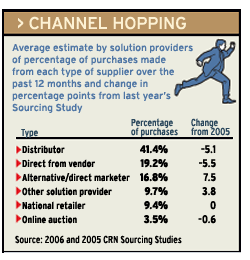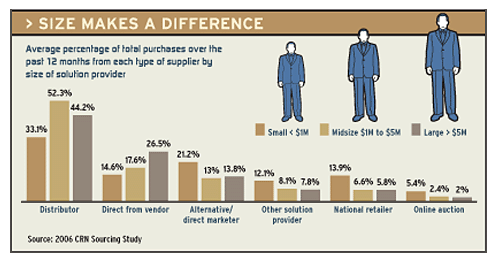Channel Shopping: VARs Are Sourcing More From VARs
According to the 2006 CRN Sourcing Study, solution providers estimated that 9.7 percent of their total purchases were made from other solution providers. That's up 3.8 percentage points over 2005.
Fueling that growth is a host of peer-to-peer players selling everything from spam filter appliances to managed network monitoring services. Steve Harper, president of Network Management Group Inc. (NMGI), a solution provider in Hutchinson, Kan., said the number of VARs signed up to sell NMGI's DoubleCheck Email manager appliance grew from 100 to 175 last year and his revenue for the antispam device doubled.
"Because we are a VAR, we understand what other VARs want," Harper said. "We have a low-cost barrier to entry, there are no sophisticated certifications needed to sell the product, and we have impeccable and free technical support. Being a VAR, we get it. We understand their pain and what they want."
Harper, too, said that because NMGI is a VAR rather than a vendor, it understands the value of the VAR as a brand to his or her customer. "We allow VARs to brand and take ownership of the product," he said. "It can be their own antispam product. If I sell Symantec, I don't have that choice."

The ability to brand their own solution is what's driving sales to other solution providers and keeping peer-to-peer margins higher than those solution providers see from vendors, said John Williams, CEO of Efolder.com, an Atlanta VAR that sells its IP-based backup services exclusively through other VARs. Efolder.com allows VARs to sell its data backup services under the VAR's own brand and then pays the VAR a monthly recurring revenue for the service.
"We understand the VAR market because we are a VAR ourselves," Williams said. "We knew that backup is like banking—you want a personal banker and people trust their data to people they know. And they know their VARs."
Efolder.com works with more than 100 VARs, and Williams said revenue is growing at a run rate of about 400 percent per year. VARs can realize margins in excess of 100 points, he said.
"My [vendor] competitor goes to the VAR and says, 'I want you to sell my product.' I go to the VAR and say, 'I want you to sell your product.' That's a whole different thing," Williams said. "Because I don't have to build the brand recognition, it saves me a tremendous amount of cost and I pass that back as margin to them. What they are doing is getting very high margins; they are building a brand name for themselves and they are making themselves unique in the marketplace."
The CRN Sourcing Study shows that smaller solution providers were more likely to source a higher percentage of total purchases from other solution providers. Solution providers with less than $1 million in annual revenue sourced about 12.1 percent of their purchases from their peers. By contrast, solution providers with annual revenue between $1 million and $5 million said 8.1 percent of their purchases come from their peers while those with revenue greater than $5 million said 7.8 percent of purchases come from other solution providers.
But solution providers that sell to other solution providers predict those numbers will grow substantially in the future.
VARs know who the good solution providers are and are going after them, according to Williams. "It's a land grab out there," he said.
